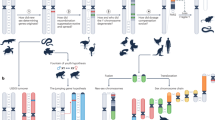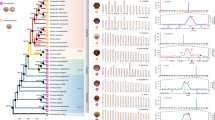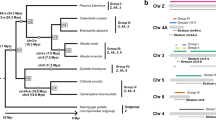Abstract
Prevailing models of sex-chromosome evolution were largely inspired by the stable and highly differentiated XY pairs of model organisms, such as those of mammals and flies. Recent work has uncovered an incredible diversity of sex-determining systems, bringing some of the assumptions of these traditional models into question. One particular question that has arisen is what drives some sex chromosomes to be maintained over millions of years and differentiate fully, while others are replaced by new sex-determining chromosomes before differentiation has occurred. Here, I review recent data on the variability of sex-determining genes and sex chromosomes in different non-model vertebrates and invertebrates, and discuss some theoretical models that have been put forward to account for this diversity.
This is a preview of subscription content, access via your institution
Access options
Access Nature and 54 other Nature Portfolio journals
Get Nature+, our best-value online-access subscription
$29.99 / 30 days
cancel any time
Subscribe to this journal
Receive 12 digital issues and online access to articles
$119.00 per year
only $9.92 per issue
Buy this article
- Purchase on SpringerLink
- Instant access to full article PDF
Prices may be subject to local taxes which are calculated during checkout



Similar content being viewed by others
References
Ohno, S. Sex Chromosomes and Sex-linked Genes (Springer-Verlag, 1966).
Bachtrog, D. et al. Sex determination: why so many ways of doing it? PLoS Biol. 12, e1001899 (2014).
Beukeboom, L. W. & Perrin, N. The Evolution of Sex Determination (Oxford Univ. Press, 2014).
Livernois, A. M., Graves, J. A. M. & Waters, P. D. The origin and evolution of vertebrate sex chromosomes and dosage compensation. Heredity 108, 50–58 (2012).
Bellott, D. W. et al. Mammalian Y chromosomes retain widely expressed dosage-sensitive regulators. Nature 508, 494–499 (2014).
Charlesworth, D. & Charlesworth, B. Sex differences in fitness and selection for centric fusions between sex-chromosomes and autosomes. Genet. Res. 35, 205–214 (1980).
Rice, W. R. Genetic hitchhiking and the evolution of reduced genetic activity of the Y sex chromosome. Genetics 116, 161–167 (1987).
Charlesworth, D., Charlesworth, B. & Marais, G. Steps in the evolution of heteromorphic sex chromosomes. Heredity 95, 118–128 (2005).
Jordan, C. Y. & Charlesworth, D. The potential for sexually antagonistic polymorphism in different genome regions. Genome Biol. Evol. 66, 505–516 (2012).
Wright, A. E., Dean, R., Zimmer, F. & Mank, J. E. How to make a sex chromosome. Nat. Commun. 7, 12087 (2016).
Charlesworth, B., Jordan, C. Y. & Charlesworth, D. The evolutionary dynamics of sexually antagonistic mutations in pseudoautosomal regions of sex chromosomes. Genome Biol. Evol. 68, 1339–1350 (2014).
Lahn, B. T. & Page, D. C. Four evolutionary strata on the human X chromosome. Science 286, 964–967 (1999).
Handley, L.-J. L., Ceplitis, H. & Ellegren, H. Evolutionary strata on the chicken Z chromosome: implications for sex chromosome evolution. Genetics 167, 367–376 (2004).
Ponnikas, S., Sigeman, H., Abbott, J. K. & Hansson, B. Why do sex chromosomes stop recombining? Trends Genet. 34, 492–503 (2018).
Bachtrog, D. Y-chromosome evolution: emerging insights into processes of Y-chromosome degeneration. Nat. Rev. Genet. 14, 113–124 (2013).
Charlesworth, B. The evolution of chromosomal sex determination and dosage compensation. Curr. Biol. 6, 149–162 (1996).
Charlesworth, B. Model for evolution of Y chromosomes and dosage compensation. Proc. Natl Acad. Sci. USA 75, 5618–5622 (1978).
Lucchesi, J. C. & Kuroda, M. I. Dosage compensation in Drosophila. CSH Perspect. Biol. 7, a019398 (2015).
Lucchesi, J. C. Gene dosage compensation and the evolution of sex chromosomes. Science 202, 711–716 (1978).
Crowson, D., Barrett, S. C. H. & Wright, S. I. Purifying and positive selection influence patterns of gene loss and gene expression in the evolution of a plant sex chromosome system. Mol. Biol. Evol. 34, 1140–1154 (2017).
Bull, J. J. Evolution of Sex Determining Mechanisms (Benjamin/Cummings Publishing, 1983).
Lahn, B. T. & Page, D. C. Functional coherence of the human Y chromosome. Science 278, 675–680 (1997).
Brosseau, G. E. Genetic analysis of the male fertility factors on the Y chromosome of Drosophila melanogaster. Genetics 45, 257–274 (1960).
Pokorná, M. & Kratochvíl, L. Phylogeny of sex-determining mechanisms in squamate reptiles: are sex chromosomes an evolutionary trap? Zool. J. Linn. Soc. 156, 168–183 (2009).
Rovatsos, M., Altmanová, M., Pokorná, M. & Kratochvíl, L. Conserved sex chromosomes across adaptively radiated Anolis lizards. Genome Biol. Evol. 68, 2079–2085 (2014).
Rovatsos, M., Pokorná, M., Altmanová, M. & Kratochvíl, L. Cretaceous park of sex determination: sex chromosomes are conserved across iguanas. Biol. Lett. 10, 20131093 (2014).
Rovatsos, M., Praschag, P., Fritz, U. & Kratochvšl, L. Stable Cretaceous sex chromosomes enable molecular sexing in softshell turtles (Testudines: Trionychidae). Sci. Rep. 7, 42150 (2017).
Fraïsse, C., Picard, M. A. L. & Vicoso, B. The deep conservation of the Lepidoptera Z chromosome suggests a non-canonical origin of the W. Nat. Commun. 8, 1486 (2017).
Iannucci, A. et al. Conserved sex chromosomes and karyotype evolution in monitor lizards (Varanidae). Heredity 123, 215–227 (2019).
Ross, J. A., Urton, J. R., Boland, J., Shapiro, M. D. & Peichel, C. L. Turnover of sex chromosomes in the stickleback fishes (Gasterosteidae). PLoS Genet. 5, e1000391 (2009).
Furman, B. L. S. & Evans, B. J. Sequential turnovers of sex chromosomes in African clawed frogs (Xenopus) suggest some genomic regions are good at sex determination. G3 (Bethesda) 6, 3625–3633 (2016).
Miura, I. Sex determination and sex chromosomes in Amphibia. Sex. Dev. 11, 298–306 (2017).
Ezaz, T., Sarre, S. D., O’Meally, D., Graves, J. A. M. & Georges, A. Sex chromosome evolution in lizards: independent origins and rapid transitions. Cytogenet. Genome Res. 127, 249–260 (2009).
Gamble, T. et al. Restriction site-associated DNA sequencing (RAD-seq) reveals an extraordinary number of transitions among gecko sex-determining systems. Mol. Biol. Evol. 32, 1296–1309 (2015).
Vicoso, B. & Bachtrog, D. Numerous transitions of sex chromosomes in Diptera. PLoS Biol. 13, e1002078 (2015).
Gammerdinger, W. J. & Kocher, T. D. Unusual diversity of sex chromosomes in African cichlid fishes. Genes 9, 480 (2018).
Jeffries, D. L. et al. A rapid rate of sex-chromosome turnover and non-random transitions in true frogs. Nat. Commun. 9, 4088 (2018).
Graves, J. A. M. & Peichel, C. L. Are homologies in vertebrate sex determination due to shared ancestry or to limited options? Genome Biol. 11, 205 (2010).
Pennell, M. W., Mank, J. E. & Peichel, C. L. Transitions in sex determination and sex chromosomes across vertebrate species. Mol. Ecol. 27, 3950–3963 (2018).
Zhou, Q. et al. Complex evolutionary trajectories of sex chromosomes across bird taxa. Science 346, 1246338 (2014).
McKee, B. D., Yan, R. & Tsai, J.-H. Meiosis in male Drosophila. Spermatogenesis 2, 167–184 (2012).
Berset-Brändli, L., Jaquiéry, J., Broquet, T., Ulrich, Y. & Perrin, N. Extreme heterochiasmy and nascent sex chromosomes in European tree frogs. Proc. R. Soc. B 275, 1577–1585 (2008).
Sardell, J. M. et al. Sex differences in recombination in sticklebacks. G3 (Bethesda) 8, 1971–1983 (2018).
Bergero, R., Gardner, J., Bader, B., Yong, L. & Charlesworth, D. Exaggerated heterochiasmy in a fish with sex-linked male coloration polymorphisms. Proc. Natl Acad. Sci. USA 116, 6924–6931 (2019).
Perrin, N. Sex reversal: a fountain of youth for sex chromosomes? Genome Biol. Evol. 63, 3043–3049 (2009).
Rodrigues, N., Studer, T., Dufresnes, C. & Perrin, N. Sex-chromosome recombination in common frogs brings water to the fountain-of-youth. Mol. Biol. Evol. 35, 942–948 (2018).
Meisel, R. P. & Wexler, J. R. The X chromosome of the German cockroach, Blattella germanica, is homologous to a fly X chromosome despite 400 million years divergence. Preprint at bioRxiv https://doi.org/10.1101/279737 (2018).
Davis, R. J., Belikoff, E. J., Scholl, E. H., Li, F. & Scott, M. J. no blokes is essential for male viability and X chromosome gene expression in the Australian sheep blowfly. Cur. Biol. 28, 1987–1992.e3 (2018).
Herpin, A. & Schartl, M. Plasticity of gene-regulatory networks controlling sex determination: of masters, slaves, usual suspects, newcomers, and usurpators. EMBO Rep. 16, 1260–1274 (2015).
Lubieniecki, K. P. et al. Genomic instability of the sex-determining locus in Atlantic salmon (Salmo salar). G3 (Bethesda) 5, 2513–2522 (2015).
Yano, A. et al. An immune-related gene evolved into the master sex-determining gene in rainbow trout, Oncorhynchus mykiss. Curr. Biol. 22, 1423–1428 (2012).
Sharma, A. et al. Male sex in houseflies is determined by Mdmd, a paralog of the generic splice factor gene CWC22. Science 356, 642–645 (2017).
Matsuda, M. et al. DMY is a Y-specific DM-domain gene required for male development in the medaka fish. Nature 417, 559–563 (2002).
Nanda, I. et al. A duplicated copy of DMRT1 in the sex-determining region of the Y chromosome of the medaka, Oryzias latipes. Proc. Natl Acad. Sci. USA 99, 11778–11783 (2002).
Li, M. et al. A Tandem duplicate of anti-Müllerian hormone with a missense SNP on the Y chromosome is essential for male sex determination in Nile tilapia, Oreochromis niloticus. PLoS Genet. 11, e1005678 (2015).
Hattori, R. S. et al. A Y-linked anti-Müllerian hormone duplication takes over a critical role in sex determination. Proc. Natl Acad. Sci. USA 109, 2955–2959 (2012).
Kamiya, T. et al. A trans-species missense SNP in Amhr2 is associated with sex determination in the tiger pufferfish, Takifugu rubripes (Fugu). PLoS Genet. 8, e1002798 (2012).
Foster, J. W. & Graves, J. A. M. An SRY-related sequence on the marsupial X chromosome: implications for the evolution of the mammalian testis-determining gene. Proc. Natl Acad. Sci. USA 91, 1927–1931 (1994).
Takehana, Y. et al. Co-option of Sox3 as the male-determining factor on the Y chromosome in the fish Oryzias dancena. Nat. Commun. 5, 4157 (2014).
Myosho, T. et al. Tracing the emergence of a novel sex-determining gene in medaka, Oryzias luzonensis. Genetics 191, 163–170 (2012).
Rondeau, E. B. et al. Genomics of sablefish (Anoplopoma fimbria): expressed genes, mitochondrial phylogeny, linkage map and identification of a putative sex gene. BMC Genom. 14, 452 (2013).
Hasselmann, M. et al. Evidence for the evolutionary nascence of a novel sex determination pathway in honeybees. Nature 454, 519–522 (2008).
Hall, A. B. et al. Sex determination. A male-determining factor in the mosquito Aedes aegypti. Science 348, 1268–1270 (2015).
Yoshimoto, S. et al. A W-linked DM-domain gene, DM-W, participates in primary ovary development in Xenopus laevis. Proc. Natl Acad. Sci. USA 105, 2469–2474 (2008).
Yoshimoto, S. et al. Opposite roles of DMRT1 and its W-linked paralogue, DM-W, in sexual dimorphism of Xenopus laevis: implications of a ZZ/ZW-type sex-determining system. Development 137, 2519–2526 (2010).
Bewick, A. J., Anderson, D. W. & Evans, B. J. Evolution of the closely related, sex-related genes DM-W and DMRT1 in African clawed frogs (Xenopus). Genome Biol. Evol. 65, 698–712 (2011).
Yoshimoto, S. & Ito, M. A ZZ/ZW-type sex determination in Xenopus laevis. FEBS J. 278, 1020–1026 (2011).
Bull, J. J. & Charnov, E. L. Changes in the heterogametic mechanism of sex determination. Heredity 39, 1–14 (1977).
Veller, C., Muralidhar, P., Constable, G. W. A. & Nowak, M. A. Drift-induced selection between male and female heterogamety. Genetics 207, 711–727 (2017).
Hamm, R. L., Meisel, R. P. & Scott, J. G. The evolving puzzle of autosomal versus Y-linked male determination in Musca domestica. G3 (Bethesda) 5, 371–384 (2014).
van Doorn, G. S. & Kirkpatrick, M. Turnover of sex chromosomes induced by sexual conflict. Nature 449, 909–912 (2007).
van Doorn, G. S. & Kirkpatrick, M. Transitions between male and female heterogamety caused by sex-antagonistic selection. Genetics 186, 629–645 (2010).
Roberts, R. B., Ser, J. R. & Kocher, T. D. Sexual conflict resolved by invasion of a novel sex determiner in Lake Malawi cichlid fishes. Science 326, 998–1001 (2009).
Blaser, O., Grossen, C., Neuenschwander, S. & Perrin, N. Sex-chromosome turnovers induced by deleterious mutation load. Genome Biol. Evol. 67, 635–645 (2013).
Blaser, O., Neuenschwander, S. & Perrin, N. Sex-chromosome turnovers: the hot-potato model. Am. Nat. 183, 140–146 (2014).
Saunders, P. A., Neuenschwander, S. & Perrin, N. Sex chromosome turnovers and genetic drift: a simulation study. J. Evol. Biol. 31, 1413–1419 (2018).
Charlesworth, B. Fundamental concepts in genetics: effective population size and patterns of molecular evolution and variation. Nat. Rev. Genet. 10, 195–205 (2009).
The Tree of Sex Consortium. Tree of Sex: a database of sexual systems. Sci. Data 1, 140015 (2014).
Martin, H. et al. Evolution of young sex chromosomes in two dioecious sister plant species with distinct sex determination systems. Genome Biol. Evol. 11, 350–361 (2019).
Pal, A. & Vicoso, B. The X chromosome of hemipteran insects: conservation, dosage compensation and sex-biased expression. Genome Biol. Evol. 7, 3259–3268 (2015).
Albritton, S. E. et al. Sex-biased gene expression and evolution of the X chromosome in nematodes. Genetics 197, 865–883 (2014).
Graves, J. A. M. Evolution of vertebrate sex chromosomes and dosage compensation. Nat. Rev. Genet. 17, 33–46 (2016).
Myosho, T., Takehana, Y., Hamaguchi, S. & Sakaizumi, M. Turnover of sex chromosomes in Celebensis group medaka fishes. G3 (Bethesda) 5, 2685–2691 (2015).
Nei, M. Accumulation of nonfunctional genes on sheltered chromosomes. Am. Nat. 104, 311–322 (1970).
Peck, J. R. A ruby in the rubbish: beneficial mutations, deleterious mutations and the evolution of sex. Genetics 137, 597–606 (1994).
Charlesworth, B. & Charlesworth, D. Rapid fixation of deleterious alleles can be caused by Muller’s ratchet. Genet. Res. 70, 63–73 (1997).
Gammerdinger, W. J., Conte, M. A., Acquah, E. A., Roberts, R. B. & Kocher, T. D. Structure and decay of a proto-Y region in Tilapia, Oreochromis niloticus. BMC Genom. 15, 975 (2014).
Fontaine, A. et al. Extensive genetic differentiation between homomorphic sex chromosomes in the mosquito vector, Aedes aegypti. Genome Biol. Evol. 9, 2322–2335 (2017).
Meirmans, P. G. & Hedrick, P. W. Assessing population structure: FST and related measures. Mol. Ecol. Resour. 11, 5–18 (2011).
Vicoso, B., Kaiser, V. B. & Bachtrog, D. Sex-biased gene expression at homomorphic sex chromosomes in emus and its implication for sex chromosome evolution. Proc. Natl Acad. Sci. USA 110, 6453–6458 (2013).
Wright, A. E. et al. Convergent recombination suppression suggests role of sexual selection in guppy sex chromosome formation. Nat. Commun. 8, 14251 (2017).
Meisel, R. P., Gonzales, C. A. & Luu, H. The house fly Y chromosome is young and minimally differentiated from its ancient X chromosome partner. Genome Res. 27, 1417–1426 (2017).
Vicoso, B. & Bachtrog, D. Lack of global dosage compensation in Schistosoma mansoni, a female-heterogametic parasite. Genome Biol. Evol. 3, 230–235 (2011).
Huylmans, A. K., Toups, M. A., Macon, A., Gammerdinger, W. J. & Vicoso, B. Sex-biased gene expression and dosage compensation on the Artemia franciscana Z-chromosome. Genome Biol. Evol. 11, 1033–1044 (2019).
Acknowledgements
B.V. thanks the members of the Vicoso lab for their comments and suggestions on the manuscript. This work was supported by the European Research Council under the European Union’s Horizon 2020 research and innovation program (grant agreement number 715257).
Author information
Authors and Affiliations
Corresponding author
Ethics declarations
Competing interests
The author declares no competing interests.
Additional information
Publisher’s note Springer Nature remains neutral with regard to jurisdictional claims in published maps and institutional affiliations.
Rights and permissions
About this article
Cite this article
Vicoso, B. Molecular and evolutionary dynamics of animal sex-chromosome turnover. Nat Ecol Evol 3, 1632–1641 (2019). https://doi.org/10.1038/s41559-019-1050-8
Received:
Accepted:
Published:
Issue Date:
DOI: https://doi.org/10.1038/s41559-019-1050-8
This article is cited by
-
Evolution and regulation of animal sex chromosomes
Nature Reviews Genetics (2024)
-
Evolution of a plant sex chromosome driven by expanding pericentromeric recombination suppression
Scientific Reports (2024)
-
Homeology of sex chromosomes in Amazonian Harttia armored catfishes supports the X-fission hypothesis for the X1X2Y sex chromosome system origin
Scientific Reports (2023)
-
Recurrent neo-sex chromosome evolution in kiwifruit
Nature Plants (2023)
-
The male-heterogametic sex determination system on chromosome 15 of Salix triandra and Salix arbutifolia reveals ancestral male heterogamety and subsequent turnover events in the genus Salix
Heredity (2023)




